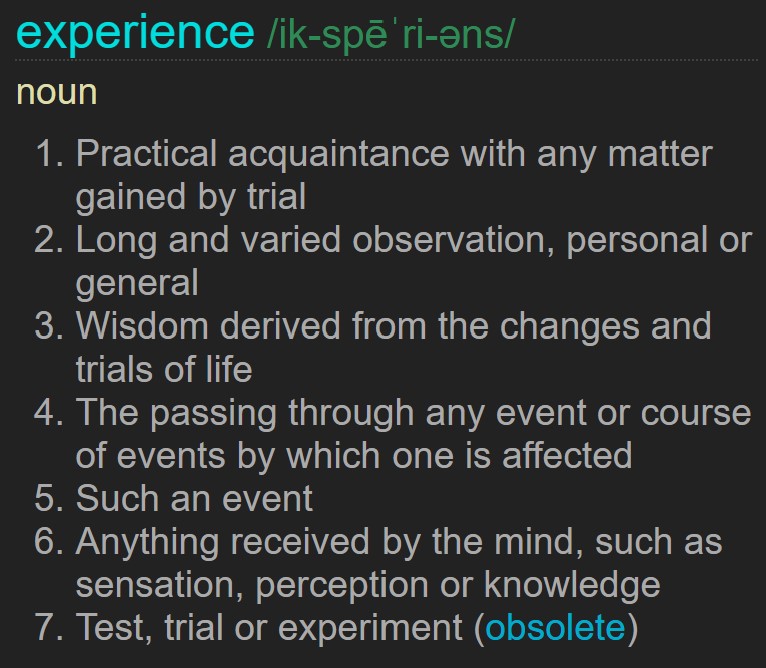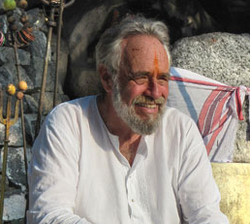Here are the definitions for the word ‘experience’ in Chamber’s dictionary:


*** Read Part 8 ***
सोऽयमात्माऽध्यक्षरमोङ्कारोऽधिमात्रं पादा मात्र मात्राश्च पादा अकार उकारो मकार इति ॥ ८ ॥
so.ayamAtmA.adhyakSharamo~NkAro.adhimAtraM pAdA mAtra mAtrAshcha pAdA akAra ukAro makAra iti || 8 ||
saH ayam AtmA – this same AtmA (just described in the 7th mantra)
adhyakSharam – adhi – concerning (i.e. from the standpoint of) – akShara – the syllables
o~NkAra – is OM.
(adhi literally means ‘making it the basis’. Shankara says that the previous mantras have concentrated on the abhidheya meaning ‘that which is being spoken of’, i.e. the thing named or denoted. OM, therefore, is effectively the abhidhAna – name or appellation. What is meant is that Atman is equated to OM in the linguistic sense.)
adhimAtraM – from the standpoint of the mAtra-s, i.e. the individual parts of OM, (note that the literal meaning of mAtra is measure; the symbolism of this will become clearer with the 10th mantra)
pAdA mAtra – the (four) aspects (of the Self) are the (four) mAtra-s
mAtrAshcha pAdA – and the letters are the aspects.
akAra ukAro makAra iti – In this manner, (the letters are) a, u and m.
This Atma can be equated to OM. The aspects of the Self are the parts of OM and the parts of OM are the aspects. The letters constituting OM are ‘a’, ‘u’ and ‘m’.
Continue reading*** Read Part 2 ***
सर्वं ह्येतद् ब्रह्मायमात्मा ब्रह्म सोऽयमात्मा चतुष्पात् || 2 ||
sarvaM hyetad brahmAyamAtmA brahma so.ayamAtmA chatuShpAt
sarvaM etad – Everything here
hi – (is)certainly
brahma – brahman.
ayam AtmA – This Atman
brahma – (is) brahman.
saH ayam AtmA – This very Atman
chatuShpad (= chatur + pAda) – (has) four aspects.
Absolutely everything is brahman. This Atman is brahman and has four aspects.
In the first mantra, OM was said to be everything. (How this is so will be analyzed in mantras 8 – 12.) The Upanishad now asks what is the nature of this Self, Atman; mantras 2 – 7 make this enquiry.
Continue readingQ: My question is one I can’t seem to clarify through any book, teacher or teaching:
How do we know that the brain isn’t responsible for consciousness? While we can observe mind with all of it’s contents as objects and then say we cannot be that which we observe, how can we be sure that there is not just some part of the brain which does the observing that is giving us this ability to watch thought? How does Vedanta address this? How can we know that the brain isn’t simply the one observing all phenomena?
Side note: I lost consciousness once due to a fall and blacked out, and all I can say is that there was complete absence of being and no one there to be aware of the non-beingness. No observer nor observed. Beyond no-thing. Absolutely no experience beyond the concept of the word. Continue reading
[Note: This is a long Q&A. Any help that other bloggers and readers can give to resolve the questioner’s concerns will be welcomed!]
Q: If waking life is a kind of dream or modulation of awareness then why is it so continuous? Many Advaitins see waking life as some form of dream, correct me if I’m wrong.
Dreams when asleep are always very new, different and unpredictable. And then they disappear and you wake up and forget the dream. And most likely you will not continue where it ended next sleep. On the other hand, waking life reappears after sleep and it is the ‘same’ as yesterday and it only seems to disappear if you die.
A: There is a lot more to it than that. And it cannot all be explained in a couple of sentences. Pretty much all of my book ‘A-U-M: Awakening to Reality’ was about this. (It is a commentary on Mandukya Upanishad and the explanation by Gaudapada.)
There are 3 states of consciousness – waking, dream and deep sleep and none of them are ‘really real’. Waking seems to be real for the waker. The dream is equally real for the dreamer (who thinks he is a waker)! The true reality is the Consciousness that is the basis of all 3 states. Waking life is said to be like a dream so that you can use this as a metaphor for gaining enlightenment. Continue reading
Without Consciousness, nothing can be known. But Consciousness itself cannot be an object of knowledge, just as in a totally dark room, a torch may illuminate everything but itself. Knowing requires both knower and known. For Consciousness to be known, it would have to be a knowable object but it is the knowing subject. We ‘know’ Consciousness because we are Consciousness. Consciousness is our true nature. The ultimate observer (which is who you essentially are) is simply not amenable to any type of objective investigation: who could there be beyond the ultimate observer to do the investigating?
Numerous attempts have been made to define Consciousness. Most seem to revolve around the assumption that a person’s behaviour indicates its presence or absence. It is argued that consciousness is present during the waking and dream states but not in deep-sleep or under anaesthesia, for example. But this is again to confuse Consciousness and awareness. When we awake from a deep-sleep, we are able to state with confidence that we were ‘aware of nothing’. This is a positive statement – there were no gross objects, emotions or thoughts present for us to perceive. Continue reading
Q: Let us suppose there are two people, one is Conscious and sleeping and the other has been knocked out UnConscious. Since everything is Consciousness both people (though Mithya), are Consciousness.
The Conscious one wakes up (let us hypothetically say we have placed an alarm and he was in deep sleep) by the underlying Turiya, as it is the substrate of all the three states i.e waking/dreaming and deep sleep. The UnConscious one does not wake up even if there is an alarm. He is not dead, like a Table or a log because he probably is still breathing and his body functions are probably going on as usual even though his mind is dormant.
I know Conscious has nothing to do with Awareness/Consciousness I am aware that at the level of Paramarthika Satyam I am the Awareness/Consciousness essence in everything including myself, the rock, the table and those two people. The UnConscious person is still breathing and is not dead like a Rock, so obviously Turiya is substrate for the breathing too. Turiya must then be the essence of a Dead body,a Rock, and the Space between everything too, even though they are not breathing. Where is the Reflected Consciousness and the locus of Turiya and the role of Prana in all this, because Turiya is equated to Atman in many circles. Continue reading
 A series of posts, presenting a new translation and commentary by James Swartz on the Panchadasi. This was presented by James as a week-long course during July 2012 and was very well received. It will be posted in around 35 parts at the rate of one part every 2 – 3 weeks. I will be editing and commenting on the material as we go and James may provide additional commentary if time allows. So there may be scope for readers to provide feedback. Please email me via the ‘Contact Form’ if you do not understand anything and wish to seek clarification.
A series of posts, presenting a new translation and commentary by James Swartz on the Panchadasi. This was presented by James as a week-long course during July 2012 and was very well received. It will be posted in around 35 parts at the rate of one part every 2 – 3 weeks. I will be editing and commenting on the material as we go and James may provide additional commentary if time allows. So there may be scope for readers to provide feedback. Please email me via the ‘Contact Form’ if you do not understand anything and wish to seek clarification.
Read Part 1 of the Panchadasi.
Follow ‘The Dreamer‘, as he embarks on an experiment in his dream state, and bumps into the sage Vasishta who begins to elaborate the nature of the waking, dream, deep sleep states, and beyond. Found in the library of the Theosophical Society, Adyar, in the 1960’s.
of
shri toTakAchArya
An Overview by C.S.Baskaran
(Part 4 – final)
Refutation of the claim by the Dvaitin that “A Principal statement like tat tvam asi is neither acceptable nor can be rejected. It does not serve any purpose”
A Principal sentence negates the identification with the three gross, subtle and causal bodies for the seriously inclined student of Vedanta and such identification is the cause of the birth and death cycle. It generates the knowledge of the self (which equates to liberation) instantaneously. If one can accept the God and Creation through the Veda pUrva (karma kANDa) texts, why not accept the same Vedas’ Principal statement “tat tvam asi” as equally valid? When a sincere seeker is taught a Principal statement like “tat tvam asi”, “aham brahmAsmi”, “ayam Atma brahman” etc, his or her own attachment to the body certainly goes away. But, in the case of ordinary people, the false notion continues, in spite of repeated hearing of the above texts. Without the removal of false identity with the body-mind-intellect complex the transmigratory existence through cycles of birth and death cannot end. Continue reading